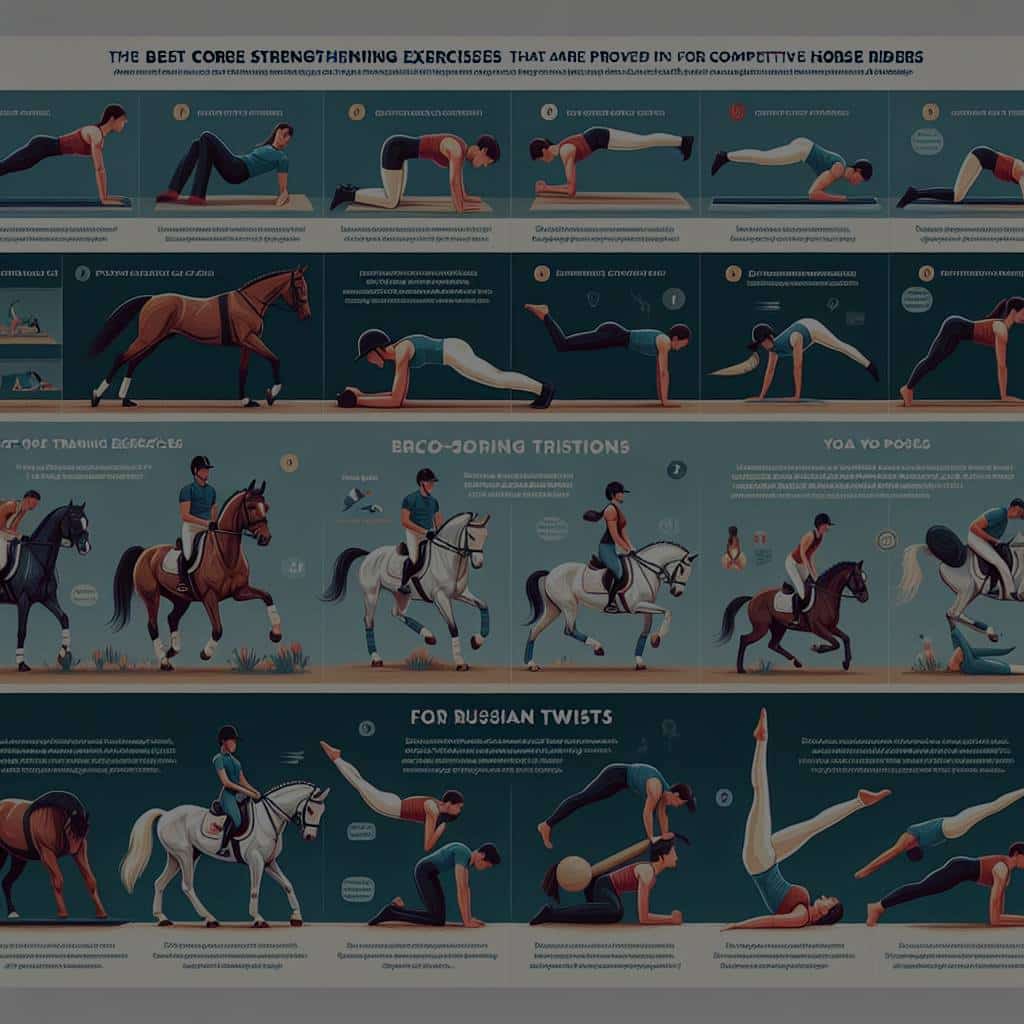What Are the Best Core Strengthening Exercises for Competitive Horse Riders?

Being a competitive horse rider challenges not only your equestrian skills but also your body’s strength and fitness. This discipline requires excellent body control, particularly of your core muscles. Here, core does not merely refer to your abs. It’s the collective term for the group of muscles that stabilize your spine, pelvis, and shoulders, which give you the balance and strength you need for riding.
Let’s dive into the best exercises that specifically target these core muscles, enhance your body’s overall strength, and improve your riding skills.
Topic to read : Which Psychological Techniques Can Help Boxers Cope with Pre-Fight Nerves?
Core Strengthening: The Foundation of a Good Rider
Before we explore the specific exercises, it is essential to understand the significance of a strong core in horse riding. Your core muscles are pivotal in maintaining a correct and stable riding position. They provide the necessary balance and control over your body movements, which will significantly influence how you communicate with your horse.
Riding is a full-body experience, and a weak core can lead to a disjointed riding style, where the upper and lower body aren’t working harmoniously. This situation could distress your horse and affect your dressage performance. So, if you aspire to become a competent rider, focusing on core strengthening exercises should be a part of your regular fitness regimen.
Have you seen this : What’s the Impact of Music Tempo on Warm-Up Efficiency in Gymnasts?
Pilates: A Versatile Routine for Riders
Pilates is an excellent exercise for riders as it focuses on enhancing the core strength and improving overall body flexibility. Pilates exercises are designed to lengthen and stretch all the major muscle groups in the body in a balanced fashion, which is highly beneficial for riders.
A regular Pilates routine will help improve your body awareness, balance, and coordination, all of which are crucial for effective horse riding. Pilates exercises such as the "Hundred", "Roll Up", and "Scissors" specifically target the core muscles, helping improve your stability in the saddle.
Yoga: A Mesh of Strength and Flexibility
Yoga is another form of exercise that can effectively strengthen your core muscles. Besides, it also improves flexibility, which is an essential ability for riders in maintaining an adaptive posture while riding. Yoga poses such as "Downward Dog", "Plank", and "Warrior II" not only fortify your core but also help in enhancing your leg and shoulder strength.
Practicing yoga regularly will help you develop a better sense of your body and its alignment, which can dramatically improve your riding style. It also contributes to enhancing your concentration and focus, which are vital in competitive dressage.
Gym-Based Strength Training
While Pilates and yoga offer a more holistic approach to core strengthening, gym-based strength training can also be extremely beneficial. Exercises like deadlifts, squats, and lunges can be highly effective in developing your leg and core strength, which is crucial for maintaining stability while riding.
Including resistance and stability ball exercises in your training routine will also help enhance your core stability and control. Remember, the objective of strength training for riders is not just about building muscle mass, but more about improving functional strength and endurance.
Floor Exercises for Core Strengthening
If gym memberships or yoga classes are not feasible, don’t worry. There are plenty of exercises you can do at home that require no equipment. These floor exercises, such as planks, bicycle crunches, and Russian twists, can effectively target your core muscles.
Moreover, exercises like leg raises, bridge pose, and Superman are beneficial for improving back strength and stability, which is crucial for maintaining a correct riding position. In addition, they also help in enhancing your lower body strength, vital for effective leg aids.
By incorporating these exercises into your routine, you can significantly improve your core strength, overall body fitness, and ultimately, your riding performance. However, it’s essential to remember that consistency is the key to seeing results from these exercises. So, make these exercises a regular part of your fitness routine, and you’ll surely see the difference in your riding skills.
Conditioning the Rider’s Upper Body
In order to fully master horse riding skills and maintain efficient communication with the horse, paying attention to the upper body strength is just as essential as working on core muscles. Upper body conditioning actually complements core stability and aids in achieving a strong, balanced riding posture.
Exercises such as push-ups, rowing, or resistance band workout can be of significant benefit in strengthening the upper body. Notably, push-ups not only develop arm and shoulder muscles but also engage the core, thereby offering a more comprehensive workout.
Rowing exercises, particularly those involving the use of a resistance band, can help to boost shoulder strength and posture. This is especially beneficial for riders, as maintaining a shoulder width posture while riding can help maximize control and engagement with the horse.
Furthermore, incorporating resistance band workouts focused on the upper body can yield excellent results. Exercises like band pull-aparts or overhead band stretches can enhance shoulder stability, upper back strength, and flexibility, making them ideal for horse riders.
Remember, a strong upper body can directly influence your riding skills by improving your stability and control in the saddle. Combined with a strong core, it can significantly enhance your overall rider fitness and performance.
Focusing on Lower Body Strength
While core and upper body strength are vital, one should not underestimate the importance of lower body strength in horse riding. The lower body, including the thighs, hips, and calves, play a pivotal role in communicating with the horse, controlling its pace, and maintaining overall stability.
Squats and lunges are great exercises for strengthening the lower body. They primarily work on the thigh muscles, but also engage the core and lower back, promoting overall body strength. Starting with your feet hip-width apart, perform these exercises with careful attention to form, to avoid injury and maximize effectiveness.
Additionally, exercises like calf raises can improve calf strength and flexibility, which is essential in horse riding for applying leg aids efficiently. You can perform these with or without weights, depending on your comfort and fitness levels.
Moreover, exercises targeting the hip muscles, such as hip bridges or side leg raises, can greatly enhance hip strength and stability. Strong hips are crucial in horseback riding, as they help absorb the horse’s motion and allow subtle shifts in weight and position.
Incorporating these exercises into your strength conditioning routine can significantly boost your lower body strength, providing a more balanced and controlled riding experience.
Conclusion: The Path to Becoming a Stronger Rider
Becoming a proficient horse rider is not merely about mastering the equestrian skills but also about being physically fit and strong. A strong core, upper body, and lower body are crucial for a balanced, controlled, and harmonious riding style.
Incorporating Pilates, yoga, gym-based strength training, and floor exercises into your fitness routine can work wonders in enhancing your core strength, body awareness, and overall muscle groups. Focusing on upper and lower body workout routines can further enhance your balance and stability in the saddle.
Remember, horse care is not only about taking care of the horse but also involves taking care of the rider’s fitness. A physically strong and fit rider can communicate and control the horse better, leading to a safer and more enjoyable riding experience.
Practice these exercises consistently, and over time, you will see a significant improvement in your riding skills, performance, and overall horse riding experience.
